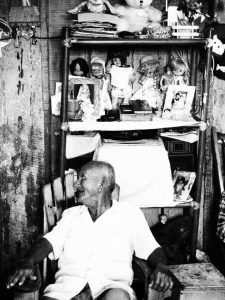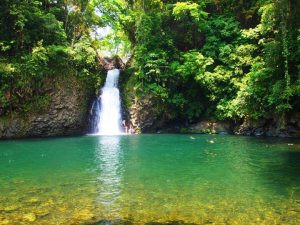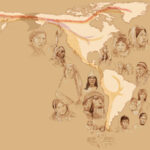Are There Witches In Mexico? Yes, Mexico embraces a rich tapestry of traditions, blending ancient beliefs with modern life, offering unique LGBTQ+ travel experiences. Gaymexico.net explores the captivating intersection of magic, culture, and inclusivity, providing a safe space for exploration and connection, while focusing on LGBTQ+ tourism, vibrant nightlife, and community events. Discover enchanting destinations, cultural insights, and LGBTQ+-friendly spaces that await your exploration.
1. Unveiling the Mystical Allure: Are There Witches in Mexico?
Yes, the presence of witches and witchcraft is deeply woven into the cultural fabric of Mexico, particularly in regions like Catemaco, Veracruz, where ancient traditions persist alongside modern life. This blend of indigenous beliefs, herbal remedies, and spiritual practices creates a unique mystical landscape.
Mexico’s witchcraft traditions represent a fascinating blend of indigenous beliefs, Spanish Catholicism, and African spiritual practices. These traditions are often localized, with variations in rituals, deities, and magical practices depending on the region and community. While some practitioners focus on healing and divination, others may engage in practices perceived as darker or malevolent. Catemaco, Veracruz, is particularly known as a center for witchcraft and brujería (witchcraft), attracting those seeking remedies, blessings, or spiritual guidance. The practices are not uniform but showcase the diverse spiritual landscape of Mexico.
1.1. Catemaco: Mexico’s Capital of Witchcraft
Catemaco, Veracruz, is renowned as Mexico’s witchcraft capital, a place where magic and spirituality are integral to daily life. For decades, Catemaco has been renowned as the epicenter of witchcraft in Mexico, attracting shamans, healers, and those seeking mystical experiences.
- Location: Situated in the lush, tropical region of Veracruz, Catemaco draws visitors and locals alike who seek the expertise of its brujos (male witches) and brujas (female witches).
- Practices: Here, you can witness a combination of white and black magic, herbal remedies, and ancient rituals passed down through generations. The blending of ancestral herbal concoctions, modern medicine, and a melting pot of magic rituals from different parts of the world, aged in a mixture of the pre-Hispanic past with a tinge of Catholicism.
- Attractions: The town offers various services, from cleansings and readings to the creation of amulets, all performed by skilled practitioners.
- Notable Figures: Enrique Marthen Berdón, descended from a long line of sorcerers, holds the title of the highest-ranked sorcerer since 2014.
1.2. The Historical Roots of Witchcraft in Mexico
Witchcraft in Mexico has deep roots in pre-Hispanic cultures, intertwined with indigenous beliefs and shamanic practices, that have evolved over centuries.
- Pre-Columbian Era: Long before the arrival of the Spanish, indigenous cultures throughout Mexico had their own spiritual leaders, healers, and diviners who communicated with the spirit world.
- Colonial Period: With the arrival of the Spanish, indigenous beliefs were suppressed, yet they often syncretized with Catholic traditions, creating new forms of folk magic and spirituality.
- Modern Era: Today, witchcraft in Mexico exists as a vibrant, living tradition, blending ancient knowledge with contemporary needs, attracting both locals and tourists.
1.3. Who Seeks Out Witches in Mexico?
People from all walks of life seek out witches in Mexico, each with their own unique motivations and desires, spanning from politicians to celebrities and tourists.
- Those Seeking Healing: Many visit witches for remedies to health problems, turning to herbal treatments and spiritual cleansings to restore balance and well-being.
- Those Seeking Love and Prosperity: Others seek assistance in matters of the heart or to improve their financial situations, hoping for spells and rituals to bring them love or fortune.
- Those Seeking Spiritual Protection: Some are drawn to witches for protection against negative energies or curses, seeking amulets and rituals to safeguard their lives.
2. Decoding the Practices: What Do Witches Do in Mexico?
Mexican witches engage in diverse practices, from herbal healing to divination, reflecting the multifaceted nature of their craft. They are healers, counselors, and spiritual guides.
- Herbalism: Witches possess extensive knowledge of medicinal plants and their properties, using them to create remedies for various ailments.
- Divination: Through practices like tarot reading, scrying, and astrology, witches offer insights into the future and guidance on life’s challenges.
- Rituals and Spells: Witches perform rituals and cast spells to influence events, bring about desired outcomes, or protect against harm.
2.1. White Magic vs. Black Magic: The Ethical Spectrum
The distinction between white and black magic reflects the intent and purpose behind the practice, influencing the kind of energy wielded.
- White Magic: It focuses on healing, protection, and positive change, aiming to bring about good fortune and well-being for oneself and others.
- Black Magic: It is associated with malevolent intentions, such as cursing, harming, or manipulating others for personal gain.
It’s important to note that the line between white and black magic can be subjective, depending on cultural beliefs and individual perspectives.
2.2. The Tools of the Trade: What Items Are Used?
Mexican witches employ a variety of tools in their practices, each serving a specific purpose in their rituals and spells.
- Herbs and Plants: Used for their medicinal and magical properties, herbs are essential ingredients in potions, amulets, and cleansing rituals.
- Candles: They symbolize light, energy, and spiritual connection, used to focus intentions and amplify spells.
- Amulets and Talismans: These objects are imbued with specific energies to protect the wearer, attract good luck, or bring about desired outcomes.
2.3. The Role of Altars in Mexican Witchcraft
Altars serve as sacred spaces for Mexican witches, providing a focal point for their spiritual work and a connection to the divine.
- Structure: Altars typically display a variety of objects, including statues of saints, candles, herbs, and personal items, each holding significance for the witch and their practice.
- Purpose: They act as a bridge between the physical and spiritual realms, allowing the witch to communicate with deities, ancestors, and spirits.
- Offerings: Witches often place offerings on their altars, such as flowers, food, or incense, as a sign of gratitude and respect.
 Witch's altar decorated with shamanic and Christian motifs, saints and demons with shady portraits and astral lines
Witch's altar decorated with shamanic and Christian motifs, saints and demons with shady portraits and astral lines
3. Embracing Diversity: LGBTQ+ Travel in Mexico
Mexico embraces diversity and offers numerous welcoming destinations for LGBTQ+ travelers, including vibrant cities and coastal paradises.
- Puerto Vallarta: Known as the “San Francisco of Mexico,” Puerto Vallarta boasts a thriving LGBTQ+ scene with gay-friendly resorts, bars, and beaches.
- Mexico City: The capital city offers a cosmopolitan atmosphere with numerous LGBTQ+ venues, cultural events, and historical landmarks.
- Cancun: Beyond its popular resorts, Cancun features a growing LGBTQ+ scene with inclusive hotels, clubs, and tours.
3.1. GayMexico.net: Your Guide to LGBTQ+ Mexico
Gaymexico.net is dedicated to providing comprehensive and up-to-date information for LGBTQ+ travelers in Mexico.
- Travel Guides: Discover detailed guides to LGBTQ+-friendly destinations, including insider tips on the best places to stay, eat, and explore.
- Event Listings: Stay informed about upcoming LGBTQ+ events, festivals, and parties happening throughout Mexico.
- Community Resources: Connect with local LGBTQ+ organizations and support groups, gaining valuable insights and assistance.
3.2. Safety Tips for LGBTQ+ Travelers
While Mexico is generally welcoming, it’s essential to take certain precautions to ensure a safe and enjoyable trip.
- Research Local Laws: Familiarize yourself with Mexico’s laws regarding LGBTQ+ rights and public displays of affection.
- Be Mindful of Public Displays of Affection: While acceptance is growing, some areas may be more conservative, so exercise discretion when showing affection in public.
- Trust Your Instincts: If a situation feels uncomfortable or unsafe, remove yourself from the situation and seek assistance.
3.3. LGBTQ+ Cultural Events and Festivals
Mexico hosts a variety of LGBTQ+ cultural events and festivals that celebrate diversity and pride.
- Guadalajara Pride: Held annually in June, Guadalajara Pride is one of Mexico’s largest and most vibrant LGBTQ+ celebrations.
- Mix Mexico Film Festival: This festival showcases LGBTQ+ cinema from around the world, promoting inclusivity and representation.
- Vallarta Pride: Every May, Puerto Vallarta comes alive with Vallarta Pride, featuring parades, parties, and cultural events.
4. Merging Worlds: Magic, Culture, and LGBTQ+ Experiences
Mexico offers unique opportunities to explore the intersection of magic, culture, and LGBTQ+ experiences, creating unforgettable journeys.
- Spiritual Retreats: Participate in spiritual retreats that combine traditional healing practices with LGBTQ+-affirming spaces.
- Cultural Tours: Embark on guided tours that delve into the history and significance of witchcraft in Mexico, while celebrating LGBTQ+ culture.
- Community Engagement: Connect with local LGBTQ+ communities through volunteer opportunities or cultural exchange programs.
4.1. Experiencing Temazcal Ceremonies
Temazcal ceremonies offer a unique opportunity to connect with ancient traditions and cleanse both body and spirit.
- What is a Temazcal? A traditional sweat lodge used for purification and healing, the temazcal is a dome-shaped structure heated with hot stones.
- The Ceremony: Participants enter the temazcal and engage in a guided ritual led by a shaman, involving chanting, prayer, and the pouring of water on the hot stones to create steam.
- Benefits: Temazcal ceremonies are believed to promote physical, emotional, and spiritual cleansing, leaving participants feeling refreshed and renewed.
4.2. Visiting the Enchanted Lagoon (Laguna Encantada)
The Enchanted Lagoon near Catemaco is a place of natural beauty and mystical energy.
- Legend: It is said that the lagoon is infinitely deep due to the energy that emanates from the portal of the cave on the unstable magnetic field that transpires the area.
- Activities: Visitors can take boat tours through the lagoon, explore the surrounding rainforest, and learn about the local flora and fauna.
- Spiritual Significance: The lagoon is considered a sacred site by local communities, who believe it possesses healing properties and spiritual energy.
4.3. Exploring Local Markets and Artisan Shops
Exploring local markets and artisan shops is an excellent way to immerse yourself in Mexican culture and discover unique souvenirs.
- Traditional Crafts: Look for handmade crafts, such as pottery, textiles, and jewelry, that reflect the region’s artistic heritage.
- Herbal Remedies: Discover local herbs and medicinal plants used in traditional healing practices, often sold by knowledgeable vendors.
- Amulets and Talismans: Find unique amulets and talismans believed to offer protection, luck, or spiritual guidance.
 Small boat through the Enchanted Lagoon with trees twisted over the body of water
Small boat through the Enchanted Lagoon with trees twisted over the body of water
5. The Darker Side: Navigating the Cave of the Devil (Cueva del Diablo)
The Cave of the Devil in Catemaco is a place shrouded in mystery and associated with dark magic practices.
- Offerings: Inside, visitors may witness offerings such as animal sacrifices, candles, and personal items left by those seeking favors from the spirits.
- Atmosphere: The cave is known for its eerie atmosphere, with the foul smell of guano from thousands of bats.
- Caution: It’s essential to approach the Cave of the Devil with respect and caution, being mindful of the energy and practices associated with the site.
5.1. Understanding the Energy of the Cave
The Cave of the Devil is believed to possess a powerful and potentially unsettling energy.
- Negative Energies: Some believe the cave is a portal for negative energies and entities, attracting those seeking to engage in dark magic practices.
- Spiritual Cleansing: It’s recommended to undergo a spiritual cleansing before and after visiting the cave to protect yourself from negative influences.
- Respectful Conduct: When visiting the cave, it’s essential to maintain a respectful attitude and avoid engaging in any practices that could be considered disrespectful or harmful.
5.2. Protecting Yourself from Negative Influences
Taking precautions to protect yourself from negative influences is essential when exploring places associated with dark magic.
- Amulets and Talismans: Wear protective amulets or talismans believed to ward off negative energies and entities.
- Spiritual Cleansing: Engage in spiritual cleansing practices, such as smudging with sage or taking a cleansing bath, to purify your energy field.
- Positive Mindset: Maintain a positive mindset and focus on uplifting thoughts and intentions to create a shield against negative influences.
5.3. When to Avoid Visiting the Cave
There may be times when it’s best to avoid visiting the Cave of the Devil, depending on your personal sensitivity and comfort level.
- If You’re Feeling Vulnerable: If you’re feeling emotionally or spiritually vulnerable, it’s best to avoid visiting the cave, as it could amplify negative feelings.
- During Dark Moon Phases: Some believe that the energy of the cave is stronger during dark moon phases, making it a more potent time for dark magic practices.
- If You Have a History of Mental Health Issues: If you have a history of mental health issues, it’s essential to consult with a healthcare professional before visiting the cave.
6. Finding Your Path: Safe and Enriching Experiences
Navigating Mexico’s mystical landscape requires awareness, respect, and a commitment to safe and enriching experiences.
- Seek Reputable Guides: When exploring witchcraft traditions, seek out reputable guides who are knowledgeable about local practices and respectful of cultural sensitivities.
- Trust Your Intuition: Pay attention to your intuition and avoid situations or practices that feel uncomfortable or unsafe.
- Respect Local Customs: Respect local customs and traditions, and avoid engaging in any behavior that could be considered disrespectful or offensive.
6.1. Resources for LGBTQ+ Travelers in Mexico
Numerous resources are available to support LGBTQ+ travelers in Mexico, ensuring safe and enjoyable experiences.
| Resource | Description |
|---|---|
| GayMexico.net | Comprehensive travel guides, event listings, and community resources for LGBTQ+ travelers in Mexico. |
| Local LGBTQ+ Organizations | Connect with local LGBTQ+ organizations and support groups for valuable insights and assistance. |
| LGBTQ+ Travel Agencies | Work with travel agencies that specialize in LGBTQ+ travel, ensuring safe and inclusive experiences. |
6.2. How to Connect with the Local LGBTQ+ Community
Connecting with the local LGBTQ+ community can enhance your travel experience and provide valuable insights.
- Attend LGBTQ+ Events: Attend local LGBTQ+ events, such as pride parades, parties, and cultural gatherings, to meet and connect with community members.
- Visit LGBTQ+ Venues: Explore LGBTQ+-friendly bars, clubs, and restaurants, where you can socialize and mingle with locals.
- Volunteer with LGBTQ+ Organizations: Volunteer with local LGBTQ+ organizations, offering your time and skills to support community initiatives.
6.3. Responsible and Respectful Travel Practices
Responsible and respectful travel practices are essential for ensuring a positive impact on local communities and the environment.
- Support Local Businesses: Support local businesses and artisans, contributing to the local economy and preserving cultural traditions.
- Respect the Environment: Respect the environment and avoid engaging in activities that could harm natural resources or wildlife.
- Be Mindful of Your Impact: Be mindful of your impact on local communities and strive to minimize any negative effects of your travels.
7. FAQs: Your Questions Answered About Witches in Mexico and LGBTQ+ Travel
Here are some frequently asked questions to help you navigate the mystical and inclusive landscape of Mexico.
- Is it safe to travel to Mexico as an LGBTQ+ person?
Yes, many destinations in Mexico are very welcoming to LGBTQ+ travelers. Cities like Puerto Vallarta, Mexico City, and Cancun have vibrant LGBTQ+ scenes and offer inclusive experiences. However, it’s always wise to research local laws and be mindful of public displays of affection in more conservative areas. - Are there real witches in Mexico?
Yes, witchcraft is a part of Mexico’s cultural and spiritual landscape, particularly in areas like Catemaco. These practitioners blend indigenous beliefs, herbal remedies, and spiritual rituals, attracting locals and tourists alike. - What kind of magic is practiced in Catemaco?
Both white and black magic are practiced in Catemaco. White magic focuses on healing and positive change, while black magic involves practices intended to harm or manipulate others. - How can I find reputable witches or healers in Mexico?
Seek recommendations from locals or visit established spiritual centers. Look for practitioners who are transparent about their practices and respectful of your beliefs. - What should I expect during a spiritual cleansing in Mexico?
Spiritual cleansings often involve the use of herbs, incense, and rituals to purify your energy. The experience can be very personal and may vary depending on the practitioner. - Are there LGBTQ+-friendly temazcal ceremonies in Mexico?
Yes, some spiritual retreats offer temazcal ceremonies in LGBTQ+-affirming spaces, ensuring a safe and inclusive environment. - What are some popular LGBTQ+ events in Mexico?
Popular LGBTQ+ events include Guadalajara Pride, Mix Mexico Film Festival, and Vallarta Pride, all celebrating diversity and pride. - How can I connect with the local LGBTQ+ community in Mexico?
Attend LGBTQ+ events, visit LGBTQ+-friendly venues, or volunteer with local LGBTQ+ organizations to connect with community members. - What resources are available for LGBTQ+ travelers in Mexico?
Gaymexico.net offers comprehensive travel guides, event listings, and community resources. Local LGBTQ+ organizations and specialized travel agencies can also provide valuable support. - What should I do if I feel unsafe as an LGBTQ+ traveler in Mexico?
Trust your instincts, remove yourself from the situation, and seek assistance from local authorities or LGBTQ+ organizations. Knowing local emergency numbers and having a plan can also be helpful.
8. Embrace the Magic and Diversity of Mexico
Mexico offers a captivating blend of magic, culture, and LGBTQ+ experiences, inviting you to embark on a journey of discovery and self-expression. Whether you’re drawn to the mystical traditions of Catemaco or the vibrant LGBTQ+ scene of Puerto Vallarta, Mexico has something to offer every traveler.
We invite you to explore gaymexico.net, your ultimate resource for LGBTQ+ travel in Mexico. Discover detailed travel guides, find upcoming events, and connect with the local LGBTQ+ community. Plan your unforgettable adventure today and experience the magic and diversity of Mexico!
Address: 3255 Wilshire Blvd, Los Angeles, CA 90010, United States.
Phone: +1 (213) 380-2177.
Website: gaymexico.net.
